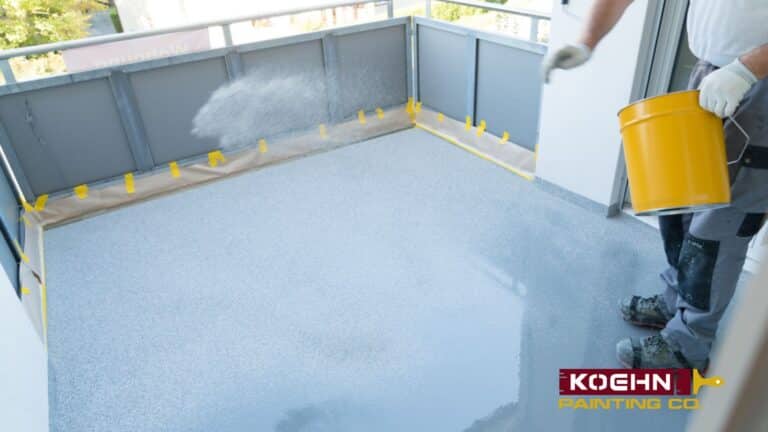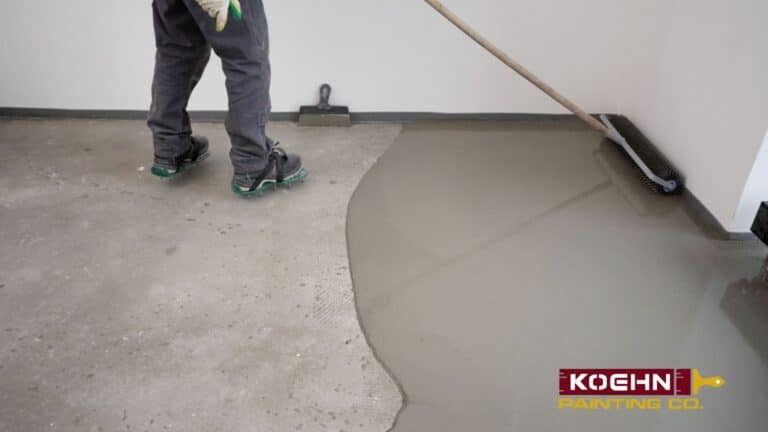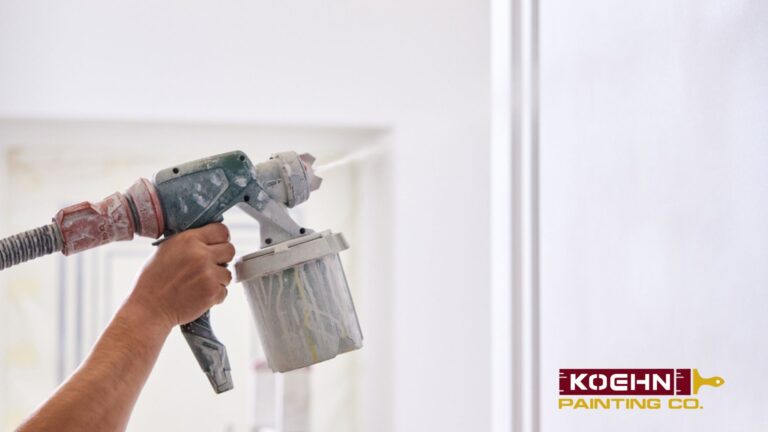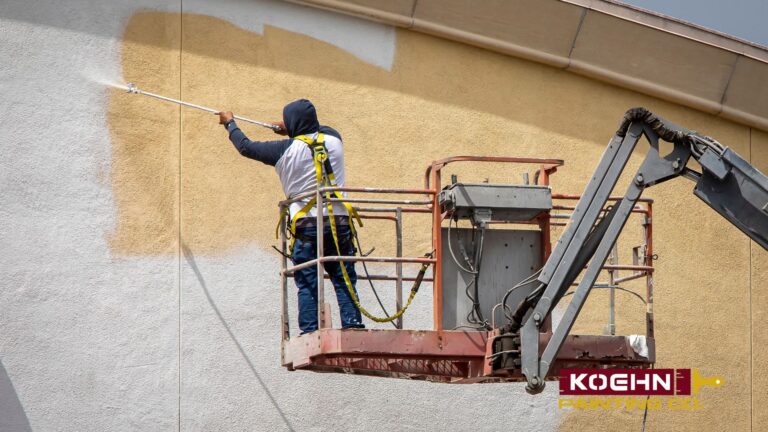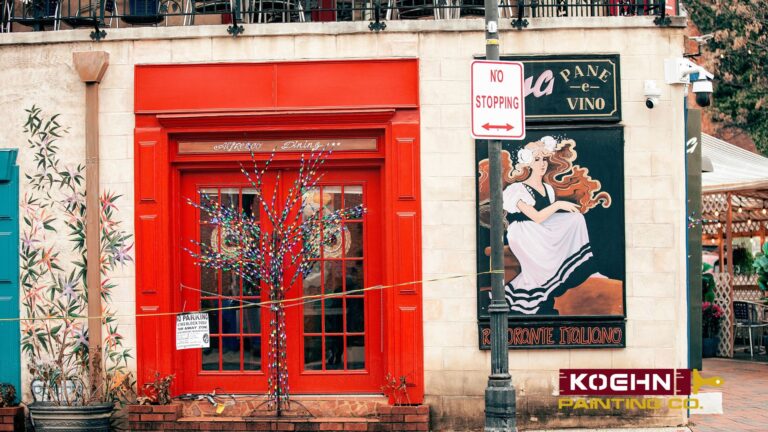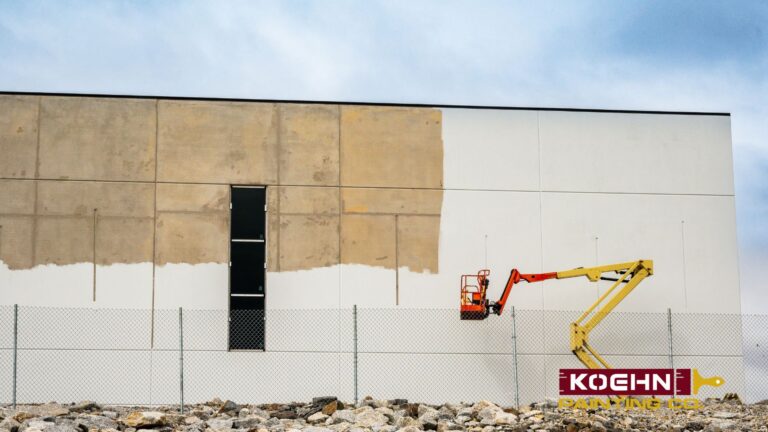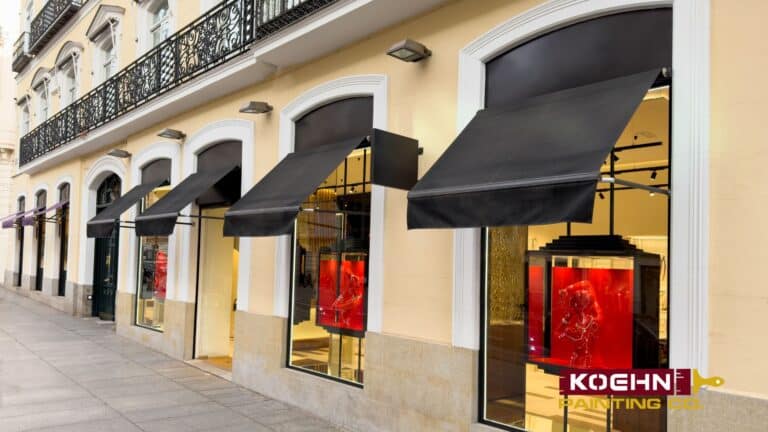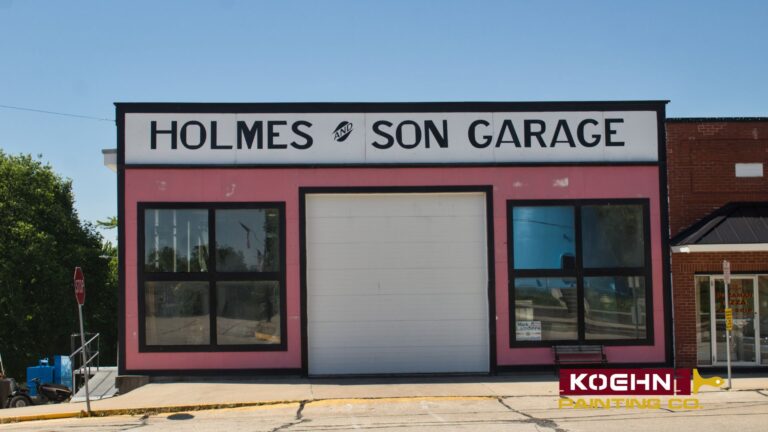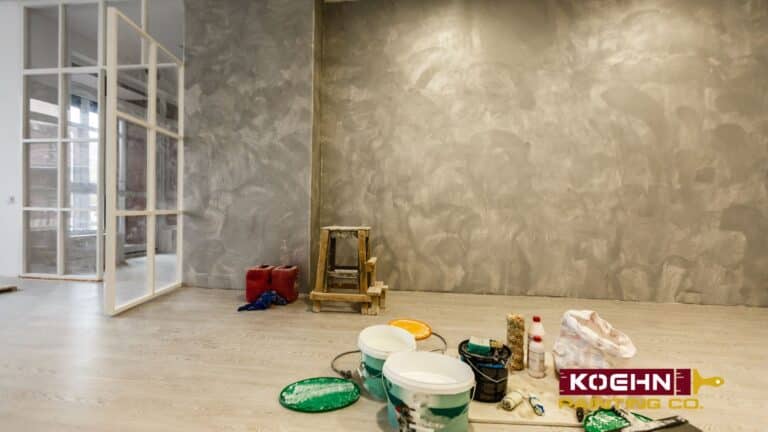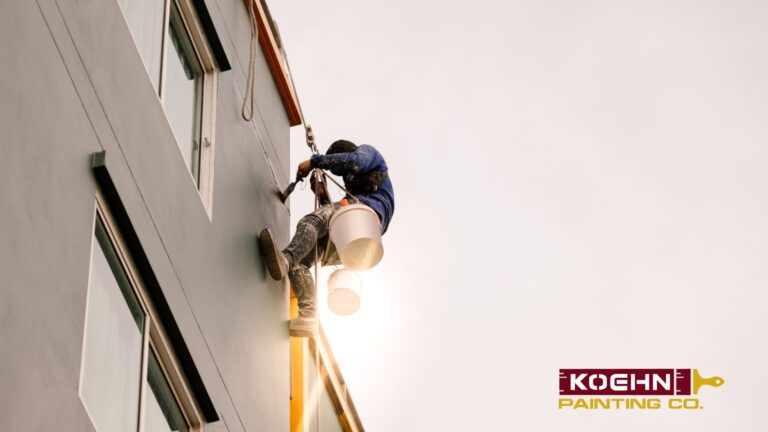Key Differences Between Commercial and Residential Painting
When it’s time to paint —talking about both commercial and residential painting— the choice of materials and techniques can differ significantly due to the nature of the environment, the surfaces involved, and the intended use.
While both types of painting are crucial for maintaining the aesthetics and functionality of a space, understanding the key differences between commercial and residential painting ensures you choose the right approach for each unique scenario.
We’ll break down the main distinctions between the two and highlight what to consider before embarking on a painting project. But first, let’s cover the basics of commercial and residential painting, so you can better appreciate how they differ.
What Is Commercial Painting?
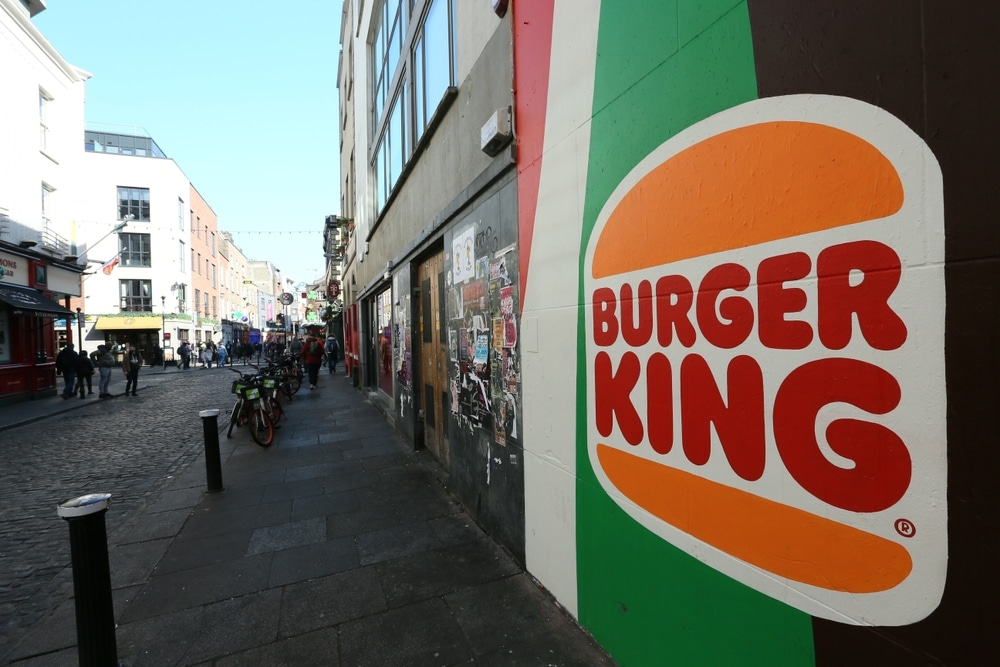
When it comes to commercial painting, the focus shifts from purely aesthetics to both functionality and durability.
Commercial spaces, such as office buildings, warehouses, retail stores, and industrial facilities, often require paints and coatings that can withstand heavy use, abrasion, and harsh environmental conditions. This is where we begin to see why commercial and residential painting are not the same.
Commercial painting is designed to ensure the longevity of surfaces while maintaining a professional appearance, which is critical in business environments. For example:
- Office buildings: Coatings that withstand wear from foot traffic and cleaning.
- Retail stores: Paints that need to maintain their appearance despite heavy foot traffic.
- Warehouses and factories: Coatings designed to resist dirt, spills, and environmental exposure.
- Healthcare facilities: Use of antimicrobial paints and coatings to maintain hygiene standards in hospitals and clinics.
- Educational institutions: Durable and safe finishes for classrooms and common areas, often incorporating colors that promote learning and well-being.
It’s also important to distinguish commercial painting from industrial painting. While both require durable and long-lasting coatings, industrial painting typically refers to manufacturing facilities, factories, or plants, where coatings must endure much harsher conditions such as exposure to chemicals, extreme temperatures, or heavy machinery.
So, in general, the main characteristics of commercial painting could include:
- Aesthetic Focus: Emphasizes creating a welcoming and professional atmosphere through color schemes and finishes that align with branding and customer expectations.
- Durability: Utilizes paints and coatings that can resist wear and tear from foot traffic, cleaning, and environmental factors, ensuring longevity in public spaces.
- Regulatory Compliance: Adheres to safety and environmental standards, including the use of low-VOC (Volatile Organic Compounds) paints to ensure indoor air quality and occupant health.
- Specialized Techniques: Employs methods like spray painting, roller application, and precision masking to achieve clean lines and consistent finishes in complex commercial environments.
In summary, commercial painting focuses on both aesthetic and durability, ensuring that commercial spaces look professional and withstand heavy use and harsh conditions.
Now that we know what commercial painting is, what is residential painting?
What Is Residential Painting?
Residential painting is primarily focused on enhancing the aesthetic appeal of a home, but it also provides an important layer of protection for surfaces like walls, trim, and furniture.
In residential settings, the paint applied is generally designed to withstand mild conditions, making it an ideal solution for creating a comfortable and visually appealing atmosphere.
While both indoor and outdoor painting projects are essential, residential painting is generally less focused on extreme durability compared to commercial or industrial painting.
In residential painting, projects vary in scope and complexity, but typical tasks include:
- Interior Painting: This includes painting rooms, hallways, trim, ceilings, and sometimes cabinetry or furniture. Living rooms, bedrooms, and kitchens are common interior painting areas that benefit from fresh color and texture. Interior paints are formulated to provide resistance against dust, minor stains, and wear caused by furniture or foot traffic.
- Exterior Painting: This involves painting the exterior of homes, such as siding, trim, fences, and doors. The goal is to protect these surfaces from UV rays, moisture, and weathering, while also adding curb appeal. This is often done with paints specifically designed for outdoor environments, providing a durable finish that stands up to the elements but may require periodic maintenance due to exposure.
- Apartment and Condo Painting: This can involve both interior and exterior surfaces, but often includes more customized finishes due to space constraints. It also requires adherence to certain building codes and aesthetic guidelines depending on the property’s rules.
Residential paints come in a variety of types and finishes to suit different surfaces and needs. The most common types include:
- Latex Paint (Water-Based): Popular for interior painting, it dries quickly, is easy to clean, and is less harmful to the environment due to low VOC levels.
- Oil-Based Paint: Often used for exterior projects and areas exposed to wear and tear, it offers a glossier finish and greater durability, though it takes longer to dry and requires stronger cleaning products.
- Acrylic Paint: Ideal for both interior and exterior surfaces, acrylic paint provides excellent color retention, fade resistance, and flexibility, making it a popular choice for homes exposed to temperature changes.
As for finishes, flat, matte, eggshell, satin, and gloss are commonly used:
- Flat/Matte: Best for low-traffic areas like bedrooms and ceilings, offering a smooth finish that hides imperfections.
- Satin: Slightly more durable, ideal for kitchens or bathrooms as it’s resistant to moisture and cleaning.
- Gloss: Provides a shiny, reflective finish, often used on trim, doors, and furniture for a more polished, durable look.
In summary, residential painting is all about enhancing the aesthetic appeal of a home while providing protection for surfaces like walls, trim, and furniture.
Now that we’ve covered the ins and outs of residential painting, let’s dive into the 7 key differences between residential and commercial painting, because understanding these differences will help you choose the right approach for whatever project you’re tackling next!
7 Differences Between Residential and Commercial Painting
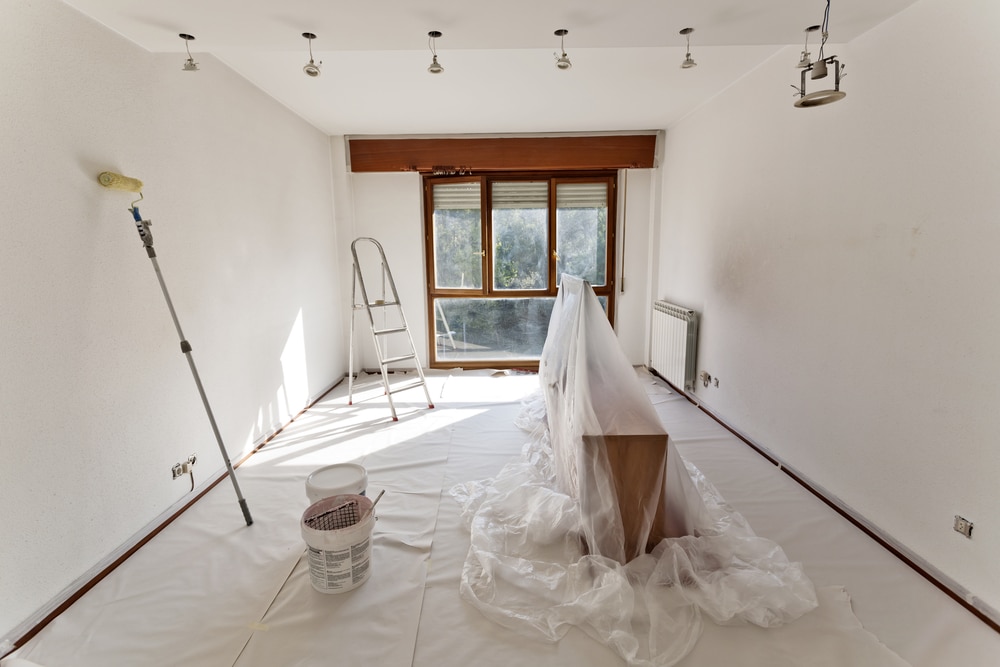
While both residential and commercial painting projects serve to enhance spaces and provide protection, the scope, scale, and requirements for each type of project are not the same.
Understanding these differences can help you make more informed decisions and ensure the success of your painting project, no matter the size or complexity.
Let’s dive into the seven key differences between commercial and residential painting
#1 Project Scale and Size
Commercial painting projects typically involve larger spaces such as office buildings, warehouses, retail stores, and industrial facilities. These projects often require painting expansive surfaces, multiple stories, and areas with limited access.
In contrast, residential painting focuses on smaller-scale projects like single-family homes, apartments, and condominiums, with more straightforward access and fewer obstacles.
Imagine painting a multi-story office building; this involves scaffolding and lifts to reach high areas, while painting a single-story home may only require ladders.
#2 Types of Paint and Materials
Commercial and residential painting differ in the types of paints and materials used.
Commercial painting often requires industrial-grade paints designed for durability and resistance to heavy wear, such as epoxy coatings for floors or fire-retardant paints for safety compliance.
Residential projects, on the other hand, prioritize aesthetic finishes and may use paints with lower levels of volatile organic compounds (VOCs) for better indoor air quality.
For example, a hospital may use antimicrobial coatings in patient rooms, while a home’s interior may feature matte or satin finishes for visual appeal.
#3 Equipment and Techniques Used
The equipment and techniques used in commercial and residential painting can vary significantly.
Commercial painters often use specialized tools like scaffolding, lifts, pressure washers, and industrial sprayers to handle large-scale projects efficiently.
Residential painters typically use smaller equipment such as rollers, brushes, and ladders, focusing on detailed work and precision.
For example, painting a high-rise building requires aerial lifts and safety harnesses, while painting a living room may only need a step ladder and a roller.
#4 Team Size and Project Duration
Commercial painting projects usually involve larger crews working extended hours to meet tight deadlines, often during off-hours to minimize disruption to business operations.
Residential painting projects are generally completed by smaller teams during regular hours, with a focus on quality and attention to detail.
#5 Scheduling and Working Hours
Scheduling for commercial and residential painting projects differs based on the nature of the space. Commercial projects often require work during nights or weekends to avoid interfering with business activities, necessitating coordination and flexibility.
Residential projects offer more flexibility, with homeowners typically choosing convenient times for the work to be done.
For example, a restaurant may schedule painting during closed hours to prevent customer disruption, whereas a homeowner can schedule painting during weekdays.
#6 Safety Requirements and Insurance
Commercial painting projects are subject to stricter safety regulations and insurance requirements due to the larger scale and potential hazards involved. Compliance with OSHA standards is essential, and contractors must carry appropriate liability and workers’ compensation insurance.
Residential painting also requires safety measures, but the risks are generally lower, and insurance requirements may be less stringent.
Painting a factory’s interior may require fall protection systems and specialized training, whereas painting a home’s exterior may only necessitate basic ladder safety.
#7 Cost Factors
The cost of commercial and residential painting projects varies based on several factors, including project size, materials used, labor, and duration.
Commercial projects often involve higher costs due to the need for specialized materials, equipment, and larger crews.
Residential projects tend to be more affordable, with costs influenced by the complexity of the work and the quality of finishes chosen.
Repainting a commercial warehouse may cost significantly more than repainting a single-family home’s interior due to the scale and materials involved.
So, what is the difference between commercial and residential painting? Well, we see there’s more than just one. It’s clear that while both types of projects share the goal of enhancing spaces and providing protection, their scope, materials, time, and execution are quite different.
Knowing the difference between commercial and residential painting will ensure that your painting project runs smoothly, meets your needs, and lasts for years to come.
Maintenance and Longevity of Paints and Coatings
Maintenance is key to preserving the look and function of painted or coated surfaces in both residential and commercial spaces. However, the level of maintenance required for commercial coatings is generally higher due to the harsh environments they face.
- Residential paints typically need to be touched up every few years, especially on exterior surfaces exposed to the elements.
- Commercial coatings require more regular inspections and maintenance, especially in industrial settings where machinery, chemical spills, or constant foot traffic can cause surface wear and tear.
In conclusion, it’s really helpful to understand the differences between commercial and residential painting, especially if you want to make informed decisions about your painting project.
Can a Painting Company Do Both?
Many painting companies offer full-service options, handling both residential and commercial painting. These companies are equipped to handle a variety of projects, from single-family homes to large office buildings, and can provide specialized services, including decorative finishes, industrial coatings, and surface preparation.
A full-service painting company offers several advantages:
- Consistency in Quality: A versatile team ensures consistent quality across both residential and commercial projects.
- Expertise in Various Techniques: These teams are skilled in everything from decorative painting for homes to industrial coatings for commercial facilities.
- Cost Efficiency: Working with a single company can reduce costs by bundling services for multiple projects, saving time and money.
- Streamlined Communication: With one team handling residential and commercial work, communication is easier and more efficient.
A versatile painting company should have the necessary certifications, such as OSHA compliance for commercial projects and EPA certifications for residential work, ensuring they meet industry standards in both sectors.
So, How do You Choose The Right Painting Contractor
When choosing a contractor, ensure they have credentials specific to residential and commercial painting. Residential contractors focus on aesthetics and decorative finishes, while commercial contractors need experience in large-scale projects, compliance with building codes, and industrial-grade materials.
Questions you can ask before hiring:
- Do you have experience in both residential and commercial painting?
- Can you provide references or examples of previous work?
- Are you licensed, bonded, and insured?
- What is your safety protocol, and are you compliant with regulations?
- What is the timeline and cost estimate for my project?
A reputable contractor should also provide reviews, a portfolio of past projects, and proof of licensing and insurance. These credentials help verify their ability to meet your specific needs while protecting you and your property.
Here are some Frequently Asked Questions (FAQs) from people looking to pursue a residential or commercial painting project:
Can a painting company handle both residential and commercial projects?
Yes, many full-service painting companies are equipped to handle both types of projects with the right expertise, tools, and materials.
How do I choose the right painting contractor?
Look for contractors with experience in both residential and commercial painting, along with proper licensing, insurance, and references.
What should I ask a painting contractor before hiring them?
Ask about their experience, safety measures, portfolio, licensing, and the timeline for your project.
What are the benefits of hiring a full-service painting company?
A full-service company provides consistent quality, expertise in various techniques, and cost savings by handling both residential and commercial projects.
Conclusion: Commercial and Residential Painting Is Different

When discussing commercial and residential painting projects, choosing the right contractor can make all the difference. Understanding the unique requirements of each type of project, from paint types to scheduling and safety measures, ensures you make informed decisions that lead to successful outcomes.
Hiring a full-service painting company can provide the flexibility and expertise needed to handle both residential and commercial work. With the right team, your project will not only meet expectations but exceed them, bringing your vision to life with lasting results.
Remember, investing in a skilled contractor isn’t just about completing the job; it’s about ensuring long-term value and quality. Whether you’re enhancing a home or maintaining a commercial space, the right contractor will ensure your space looks its best for years to come.

